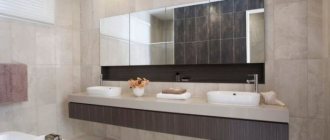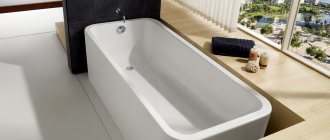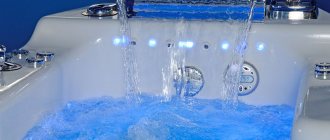Despite the growing popularity of showers, traditional baths are not losing ground. After all, they are created for complete relaxation and restorative sessions using essential oils, sea salt or aromatic foam. In terms of comfort, the latest generation models are in no way inferior to hydroboxes. But it's important to know which bath is betterso as not to make a mistake with your choice and enjoy water procedures for a long time.
The first thing you should pay attention to is the material and manufacturing technology. Not only the operational characteristics of the bowl, but also its appearance, as well as transportation and installation options depend on these parameters.
Today baths are made from:
- cast iron
- become
- acrylic
- kvarila
- tempered glass
- stone – natural or artificial
- tree
- copper
Steel, cast iron and acrylic are the most widely used - they are used both in mass production and for the production of luxury products. The remaining materials are intended for creating designer models, mainly in the singular.
Features of cast iron baths
They have a long history. Having appeared in our everyday life back in the 17th century, cast iron bathtubs still remain leaders in the plumbing market, despite growing competition and the emergence of new materials. Isn't this evidence of their undeniable advantage over their steel and acrylic counterparts?
Advantages of cast iron baths
- Low thermal conductivity. The water in such a bowl does not cool down for a long time, allowing us to bask in special comfort. However, it cannot be said that cast iron holds the lead in heat capacity; with the advent of acrylic, it had to “make room”. It turned out that the polymer hot tub keeps water hot 2 times longer.
Of course, a lot depends on the thickness of the walls of a particular model, ventilation in the bathroom and other conditions. Therefore, it is difficult to say unequivocally which bathtub is better - acrylic or cast iron , when it comes to heat capacity.
- Durability. At this point, the cast iron bathtub is still out of competition. Its minimum service life is 50 years, but this is far from the limit. If treated with care and cleaned with mild detergents without abrasive particles and caustic acids, the bowl will retain its enamel coating, which means it can serve more than one generation of the family.
Tip : when bathing your pets, it is better to place a rubber mat in the bathtub so as not to scratch its surface. For the same reason, it is not advisable to place metal buckets and other containers in the font that can damage the enamel.
- Sustainability. Another undeniable advantage of cast iron plumbing. Due to its massiveness, the font will not tip over, even if a person with a lot of weight sits on its edge.
- Enamel strength. The coating does not fade over time, does not become thinner, and causes a pleasant tactile sensation. The outer side of the bowl is often painted in bright colors, which allows you to diversify the design of the products. But enamel requires special care, otherwise it will turn yellow, become covered with microcracks and begin to deteriorate.
- Low noise level. The bath fills almost silently. This is the advantage of a cast iron bowl over a steel one.
- Easy to care for. Unlike, for example, acrylic models, cast iron bathtubs are not capricious and do not require special cleaning products. On the contrary, they are recommended to use a simple soap solution with vinegar, washing powder, bleach or soda.
But you need to wash the bath regularly, after each use. If there is no serious contamination, warm water will be enough, and if there are stains, rusty streaks or deposits, you can use any alkaline-based product.
Important: after washing, the bowl should be dried. Then lime deposits and rust will not appear in places where the enamel is chipped or near the drains. If the humidity in the bathroom is low, you can simply open the door and wait until the surface of the bathtub dries. If this is not enough, wipe the bowl with a paper towel.
Disadvantages of cast iron baths
- The large weight of a cast iron bathtub easily turns from an advantage into a disadvantage when it comes to delivery and installation of the product.
The wall thickness of a high-quality bowl should be at least 5 mm; it is not surprising that its weight ranges from 90 to 120 kg. It is impossible to lift such a plumbing fixture to a high floor alone - the participation of 3-4 people will be required. A bulky full-size bathtub will not fit in a passenger elevator, so in the absence of a freight elevator, it is carried up the stairs, where there is an additional problem of turning around on the landings between flights.
At least two people are also involved in installing the font. All this creates difficulties and makes you doubt the advisability of purchasing a cast iron model.
Attention: bathtubs from foreign manufacturers have thinner walls and are much lighter, without losing any quality. Particularly famous are the products of the Catalan brand Roca, which in 1925 was the first to begin mass production of cast iron bathtubs.
- Difficulty of restoration. If chips or cracking of the enamel appear, you will have to use the services of specialists, since restoring the coating at home is problematic.
- Monotony. Cast iron has little flexibility when processed, so products made from it have a simple shape, close to the classic one: oval, rectangular or triangular (for corner models). Those who love extraordinary modern design are unlikely to like such restrictions.
When to choose a cast iron bathtub
A cast iron font on curved carved legs in the shape of lion paws is perfect for a bathroom in the Empire, Provence, retro or shabby chic style. An elegant bathtub can be freely installed with the rest of the composition around it.
A stable bowl will not require additional support, as is usually the case with steel or acrylic models. There will also be no need to build a podium to hide the unsightly auxiliary structure.
A classic style cast iron bathtub looks strict and elegant. Especially if the outer covering is painted in pastel colors or covered with hand painting.
Families with small children, elderly people or people with a lot of weight should also pay attention to cast iron models. Moreover, today manufacturers equip hot tubs with special internal handles, anti-slip coating and a comfortable seat for those who do not want to be completely immersed in water.
And for lovers of home spa treatments, cast iron bathtubs with hydromassage nozzles began to be produced. True, such devices are considered elite and cost accordingly.
What types of installation are there?
Depending on how they are placed in the bathroom, there are:
- Freestanding
This option involves installation in spacious rooms. In this case, the form can be whatever the owner wishes. There are even larger models designed for two people.
One type of free-standing device is a built-in bathtub. Plumbing fixtures are installed on a special podium or, conversely, lowered to floor level. Then it resembles a mini-pool.
- Wall mounted
The most common type for an apartment or private house in which the size of the bathroom does not have a large area. The device is installed close to the wall and thus saves space. The optimal shape for this type of installation would be a rectangular or corner bathtub.
The model, located close to the wall, can serve as a shower stall: you just need to hang a curtain so as not to splash water.
Steel baths. Advantages and disadvantages
Steel plumbing belongs to the budget category. But a high-quality product can last up to 30 years without requiring replacement or large-scale restoration.
If you compare which bathtub is better - cast iron or steel , you can find arguments for and against each type.
Advantages of steel models
- Let's start with the design. Since steel baths are made not by casting, but by stamping, and the material itself is much more ductile than cast iron, strict restrictions are not imposed on the shape and size of the bowl. As a result, the model range is very diverse, allowing you to choose the appropriate option for both modern and classic interiors.
- The price of steel plumbing, as mentioned above, is very affordable, due to the complete automation of production.
- Bathtubs made of steel are at least two times lighter than cast iron. Their weight, depending on size, ranges from 15 to 50 kg. The bowl can be carried and installed alone, which is very convenient.
- Caring for a steel bathtub is much easier, and it is more hygienic. Enamel baked at high temperatures does not form microcracks, from which it is difficult to remove limescale and dirt.
- Modern models have hydromassage functions, are equipped with handles and soft headrests, do not slip, ensuring complete safety. In terms of comfort, they are superior to their cast iron counterparts and are not inferior to acrylic ones.
Easy to care for
If the enamel is applied to cast iron with high quality and has a sufficiently thick layer, then the coating is very durable. And even if the stain has penetrated deep into the enamel, it can be removed in almost any way, including chemical reagents and mechanical action. And housewives do this with great success.
Steel products are coated with thinner enamel, which, accordingly, needs to be cleaned more carefully than in the previous case. Especially when using abrasive products. Otherwise, you can damage the surface, which will be difficult to restore later.
Acrylic bathtubs are cleaned carefully, using mild care products and without using strong abrasives or aggressive chemicals. This will prevent the formation of cracks and premature failure of the product.
Cast iron bath
Steel bath
Acrylic bath
Results. On this point, our products made of cast iron turned out to be the most unpretentious, and acrylic ones modestly retreated to the very last place, third. Steel baths took the middle position. However, the steel models mentioned above, coated with the innovative “Enamel-plus” composition, can also very well lay claim to the position of leader in ease of maintenance.
Disadvantages of steel bathtubs
Steel bathtubs have as many disadvantages as advantages, but most of them can be eliminated independently, using improvised means:
- Fast cooling of water. Steel bowls do not hold heat well - this is one of the main disadvantages. But they heat up quickly, so to take a shower we don’t have to put our feet on a cold surface.
- Danger of capsizing. If we place ourselves poorly in the bathtub and disrupt its stability, we risk falling along with it.
- Deformation from gravity. Under a massive person or object, the bathtub bends, which leads to cracking of the enamel.
- Low noise absorption. The thin walls of the bathtub ring under the running water, so it’s impossible to fill it quietly.
- Rust on chips. Cast iron oxidizes much less than steel. Therefore, bowls made of this metal in places where the enamel has been chipped almost do not rust. Steel containers do not have this advantage, which is why they deteriorate much faster.
Fortunately, improving the performance of your bathtub is not difficult.
The first thing you need to do when installing the bowl is to ensure that it is securely fixed. The standard “legs” that come with the kit are usually not enough. You can build wide supports from red brick (silicate does not tolerate moisture well) - this is the most successful solution. To avoid damaging the appearance of the plumbing fixtures, all auxiliary structures and pipes are covered with a decorative screen.
Applying polyurethane foam to the back of the bowl solves two problems at once: additional sound and heat insulation appears. As a result, the water hits the walls less loudly and maintains its temperature longer. Instead of foam, you can use technical cork or vibration insulation - a bitumen-based material designed for noise protection of cars.
How to check the quality of a steel bathtub
If in the question of which bathtub is better , preference was given to a steel bowl, it is very important not to make a mistake with the choice when purchasing. Then such plumbing will last a long time, making water procedures truly comfortable. At the same time, the cost of the product will be much lower than that of the same acrylic, which does not always have an adequate price-quality ratio.
What to pay attention to:
- The thickness of the walls of the steel bath should be 2.5 - 3 mm. In the store, we cannot determine this indicator by eye, but we can move the container to feel its weight. If the bathtub gave in easily under our pressure, the manufacturer clearly saved on material by making the walls thinner than required by the standard.
- Defects in the enamel coating are another sign of low-quality plumbing fixtures. Sagging or an excessively thin layer through which the base is visible, roughness, foreign inclusions and other defects of this kind are unacceptable. If the enamel does not lie in an even layer, over time it will crack from uneven loading, making the bath unusable. The “correct” coating is smooth and pleasant to the touch, and has a uniform color.
- It is better to purchase plumbing fixtures from leading manufacturers - this is the most reliable guarantee. The German companies Kaldewei and Bette have proven themselves well, as well as Roca and BLB from Portugal. Among domestic companies, the products of the Verkh-Isetsky Metallurgical Plant, which meet modern standards and are cheaper than foreign analogues, inspire confidence.
Stainless steel baths
We are accustomed to metal hot tubs with an enamel coating, but there are, although less common, models made of stainless steel. So which bath is better ?
Stainless steel bowls are superior to enameled ones in all respects, except... price. Such bathtubs cannot be called budget - they will cost much more than plumbing fixtures made of cast iron or acrylic.
But we get a highly environmentally friendly, durable and damage-resistant product of any kind with an original, unique design.
Tip: to get rid of traces of water, which are very noticeable on polished shiny metal, the bowl should be wiped with a piece of dry natural cloth every time after bathing.
Stainless steel plumbing is an ideal choice for a bathroom in a minimalist, hi-tech or loft style.
Variety of sizes
Cast iron bathtubs made in Europe can have a length from 150 to 180 centimeters and a width from 60 to 90 centimeters. The standard length of the lower (inner) part is 110-120 centimeters. Modern technologies (changing the angle of the backrest, for example) make it possible to increase this size to 130-140 centimeters. Domestic cast iron bathtubs are made with a width of 70 centimeters and a length varying from 120 to 150 centimeters.
The variety of shapes of steel and acrylic products also implies a variety of sizes. As an example, let's take steel baths produced by the German company Kaldewei. The large model of this brand, Corpostar, has dimensions of 190 by 90 centimeters, and the small Miniform model has dimensions of 157 by 70 centimeters. The Japanese-style Kusatsu Pool model is distinguished by its increased depth (81 centimeters) and compactness (140 by 100 centimeters).
Bathtubs made from acrylic are equally varied in size. They can be large and small, wide and narrow, deep and not very deep. Corner and round options are available with different side sizes and diameters. If we talk about rectangular and oval models, their bowl can have a width from 70 to 170 centimeters, and a length from 120 to 190 centimeters.
Acrylic bath
Steel bath
Cast iron bath
Results. More modern steel and acrylic are again in the lead, leaving behind the good-quality but conservative cast iron. They make it possible to choose a product for any bathroom and for any purpose. For example, a large round bathtub can easily be used for two people at once. A compact corner option is for a small apartment.
Acrylic bathtubs: new technologies versus long-standing traditions
Bowls made of synthetic material - polymethyl methacrylate (colloquially plexiglass) are increasingly crowding out metal plumbing fixtures. The technology for manufacturing acrylic bathtubs is constantly being improved, so the growing interest in them is justified.
The price and quality of polymer baths depends on the manufacturing method. There are two of them:
- casting with subsequent reinforcement
- use of multi-layer sandwich type construction
- Products made from cast acrylic (PMMA) are produced by pressing at high temperatures. To increase strength, bathtubs are reinforced with fiberglass or polyurethane and then sanded.
Cast acrylic has a smooth surface without micropores where pathogenic flora or dirt particles could accumulate. It is easy to clean, does not crack, and can withstand heavy loads. In case of minor damage, the surface of the bathtub can be restored independently by simple grinding or treating it with special pastes.
Hot tubs made of cast acrylic are expensive, but their service life is at least 15 years.
- There is also an economy option - the so-called “sandwich”. The base is made of cheap ABC plastic and covered with a thin layer of acrylic.
It makes no sense to ask which bath is better in this case. Any damage to the acrylic coating in the sandwich bowl leads to direct contact of water with plastic, which is not moisture resistant. As a result, the bathtub is destroyed and has to be replaced with a new one. In addition, fragile plumbing fixtures can crack from impact or point loading and sag during bathing.
It is not surprising that budget options for acrylic bathtubs are designed for 3 to 4 years of service. You should buy them only in one case: if you want to regularly update the design of your plumbing fixtures, keeping up with fashion and without harming your wallet.
Manufacturers rating
According to buyers' estimates by 2020, the list of popular companies is presented by location:
| Number in the rating | Manufacturer country | Brand |
| 1 | France | Jacob Delafon |
| 2 | Russia | Aquanet |
| 3 | Poland | Excellent |
| 4 | China | Gemy |
| 5 | Poland | Cersanit |
| 6 | Russia | Triton |
| 7 | Holland | Riho |
Advantages of acrylic bathtubs
- The ability to retain heat for a long time, a pleasant to the body, non-cooling surface.
- No noise when drawing water.
- The coating does not lose color or darken.
- Lack of toxic components (only in high-quality products).
- Light weight – no more than 30 kg.
Important : a bowl that is too light should be a concern when purchasing. It is either thin-walled or made of plastic “disguised” as acrylic. The optimal thickness of the walls of a PMMA bath should be 5 – 6 mm.
- Creative design, the ability to create plastic products of complex shapes. The bowls are intended mainly for modern style bathrooms . Although you can choose a classic model.
When comparing different types of bathtubs, buyers often hesitate: which is better - acrylic or steel. Both weigh a little, especially compared to cast iron bowls, have a stylish, modern appearance and are equipped with all the necessary safety features.
True, the cost of high-quality acrylic bathtubs is much higher. But they do not rust, do not need an enamel coating, which cracks over time, and have antibacterial properties.
Disadvantages of acrylic bathtubs
- An acrylic bathtub requires a supporting frame to help distribute the load and maintain its shape. It is advisable to purchase it not separately, but together with the bowl, choosing manufacturers who offer both positions.
- Special care products will be required, since acrylic can be easily scratched with ordinary powder or an overly hard brush. Due to instability to mechanical stress, it is not recommended to bathe pets in acrylic bathtubs, which may leave claw marks.
- Danger of deformation from hot water.
Choosing an acrylic bathtub. What to pay attention to
PMMA bowls are not cheap, which is why it is so important to purchase a truly high-quality option that is worth the investment. What to look for when purchasing?
- There should not be an unpleasant “chemical” smell coming from the bathtub. If it exists, we have either a plastic analogue or a low-quality product.
- Sufficient layer of reinforcement. You can check for the presence of fiberglass treated with epoxy resin by inspecting the side of the bathtub.
- If you point a flashlight at the bowl, the light should not be visible through the thickness of the walls.
- An important signal is that the shape of the bowl is too complex. Durable, injection-molded plastic does not require elaborate bends, which most likely serve as additional stiffening ribs for a thin-walled and fragile model.
Attention: the price of an acrylic bathtub cannot serve as the only guarantee of good performance properties. It happens that we have to pay extra for a brand or an original form of plumbing fixtures, but at the same time it does not have sufficient strength to last a long time. Only cast acrylic, at least 6mm thick, with the correct reinforcement, is truly reliable.
Easy to install
Bringing a heavy cast-iron bathtub into the house is not so easy - one person cannot do it. This explains the difficulty in installing such products. They also need to be firmly fixed on a flat plane. They are usually placed on four cast legs.
To install an acrylic bathtub, you will need to assemble a metal frame and only after installing the bathtub on the frame can it be connected to the sewerage system. This makes the installation process somewhat difficult, but since all the parts are light, one person can handle it quite well.
Steel bathtubs are also fixed on legs, but their installation can be done by one person. To significantly increase sound insulation, a layer of polyurethane foam is often applied to the surface of the product or the bottom is covered with Penofol. In general, installation of a steel bathtub is the easiest.
Sound insulation of a steel bath: on the left with Penofol, on the right with polyurethane foam.
Steel bath
Acrylic bath
Cast iron bath
Results. Steel bathtubs can be called the easiest to install (however, in the case of applying polyurethane foam, the process becomes somewhat more complicated). The second place belongs to acrylic bathtubs, where you will have to tinker with making the frame. And the rating is completed by cast iron products, heavy and bulky.











